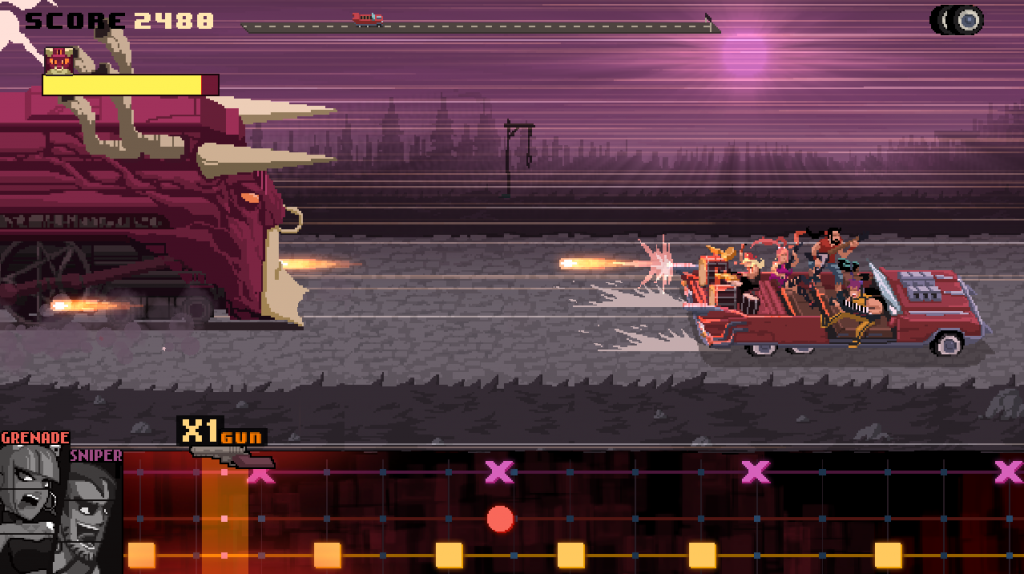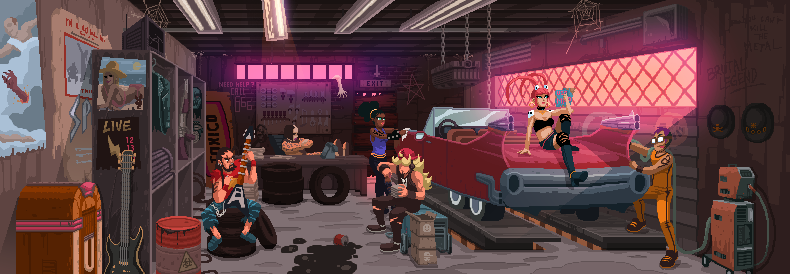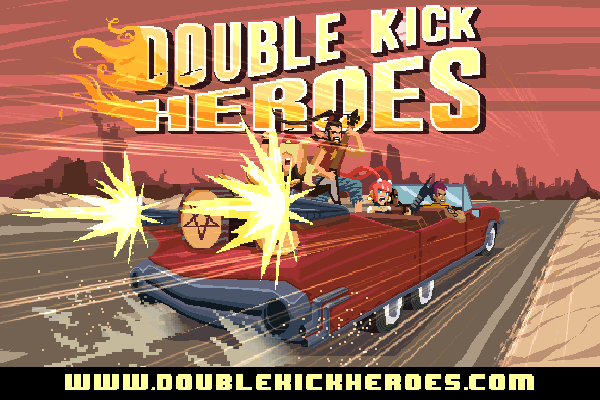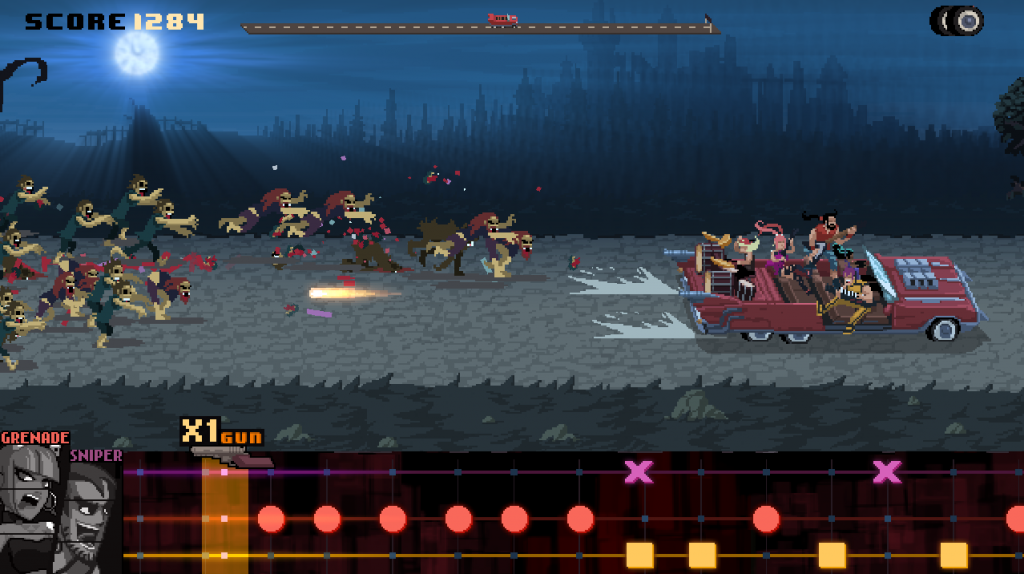Double Kick Heroes – Musical Massacre
Double Kick Heroes was one of the real surprises of EGX Rezzed 2017, and not just because the game didn’t actually have a stand, instead being walked around on a laptop by a developer. No, it was a surprise because of the fact it’s an interesting genre hybrid, and the team have built it for workshop support from day one.
It’s a rhythm game by nature, although it’s also a shooter. Players control the titular band and their Gundillac – a weaponised version of the iconic, classic version of the American convertible. In the most cases the vehicle makes it’s own way through the levels, with the band manager, Lincoln, at the helm. That leaves you to concentrate on the nitty gritty, hitting the notes in time to build up a higher score, rack up a combo and keep the rear of the vehicle safe from waves of mindless, evil undead and more.
The game’s rhythm element is a horizontal bar along the bottom part of the screen, which, at it’s busiest is populated with three lines, and controlled with four inputs. The initial lane remains the most frequently used throughout the game, with it matching the drum beats of the game’s songs, both tied to the two guns mounted on either tail-light of the Gundillac. Each of the gun’s has their own input, in the case of the fight-stick I played on these were the two main buttons. This was, at first, quite hard to get used to; as you’re not simply matching the information being given on screen (or, once you were used to the music, by the music) but also having to process the information on screen regarding where the enemies were in relation to the rear of the vehicle. That said, the game’s story eases you in gradually, and as with any rhythm game to those of us -myself included- almost completely musically inept, the gameplay loops and systems become easier with practice.
Once that’s all introduced, and in place, the game starts introducing new mechanics, two new rows of beats are introduced, each tied to their own button, and each charging up their own special attacks; grenades and sniper-shots. There’s also boss battles, which require the use of the joystick in order to change the vehicle’s place in the lane. The boss that I got to play against would charge towards the car doing massive damage, and then slink back onto the screen after it had passed. While all of the levels that I played were exceptionally well timed -we’ll get to why in a bit- the boss fights made exception use of song pacing in synching up the boss moves and enemy waves. Learn the song, and you’ve learnt the level.

I suspect that the reason the game’s enemy waves, and beats, match up so perfectly is evidenced in the included track editor. The track editor takes any submitted track’s wavelength and turns it into a interface which you can then place waves, and beats on, at your whim. Understandably, due to copyright, you can’t directly link both the track and the level and distribute them, however full Steam Workshop support will be live with Early Access allowing people who have their own copies of the tracks to match the level-set up and go crazy. The member of the team who was showing me the game had with him two tracks they’d made; one, a Sepulchre track, that had been doing the rounds for sometime; and a take on Deftones’ Back To School they’d assembled the night before. Both had perfectly timed enemy waves, breaking off during the quieter moments, and growing in intensity as the songs reached their most technical.
What’s most interesting about the level editor is the fact that, backdrops and enemy-groups aside, there’s a lot of potential for fans to create very different interpretations of songs, as well as for them to emulate a difficulty curve of their liking. This even before we talk about the fact that there will probably only be a brief moment from launch before people start designing levels for entirely different genres of music – after all, any track can be synched with it.
 Back to the songs included in the game package however. The composer of the team, Frédéric “Elmobo” Motte, who’s previous work in games includes Gobliiins and Nightmare Creatures, and also has a history as a music producer, has gone to impressive lengths to cover a variety of metal sub-genres. Impressive not just in the diversity, but also in the fact that each one would have been constructed with several difficulties and learning curves in place – I heard the same track running multiple times, and each time it translated just as well on screen even though the levels were utterly different difficulties.
Back to the songs included in the game package however. The composer of the team, Frédéric “Elmobo” Motte, who’s previous work in games includes Gobliiins and Nightmare Creatures, and also has a history as a music producer, has gone to impressive lengths to cover a variety of metal sub-genres. Impressive not just in the diversity, but also in the fact that each one would have been constructed with several difficulties and learning curves in place – I heard the same track running multiple times, and each time it translated just as well on screen even though the levels were utterly different difficulties.
Music might be the literal beat that drives the game, however the visuals were equally impressive. The game’s art style is one of highly detailed pixel-art, with contrasting colours and masses of red & orange gradients. When in motion it also has a way about it that’s very reminiscent of mid-ninties graphic adventure titles (artwork shows the Gundillac in a viewpoint that instantly reminds me of Sam & Max Hit The Road). all while set in a world that feels like it’s been ripped out of a never recorded Robert Rodriguez film. As a matter of fact, the developer showing me the game joked that the artist was stuck in the 90s which is something that is perfect for the game, and totally visible. Zero complaints from me.

The finished game will reportedly be about 6 chapters long, all playing out through the game’s included 30 tracks, and interlaced with cut-scenes and story animations. It’ll be hitting Early Access soon, with a little under a year planned there before full release. Those interested can try the demo on the developer’s website.

Comments are closed.